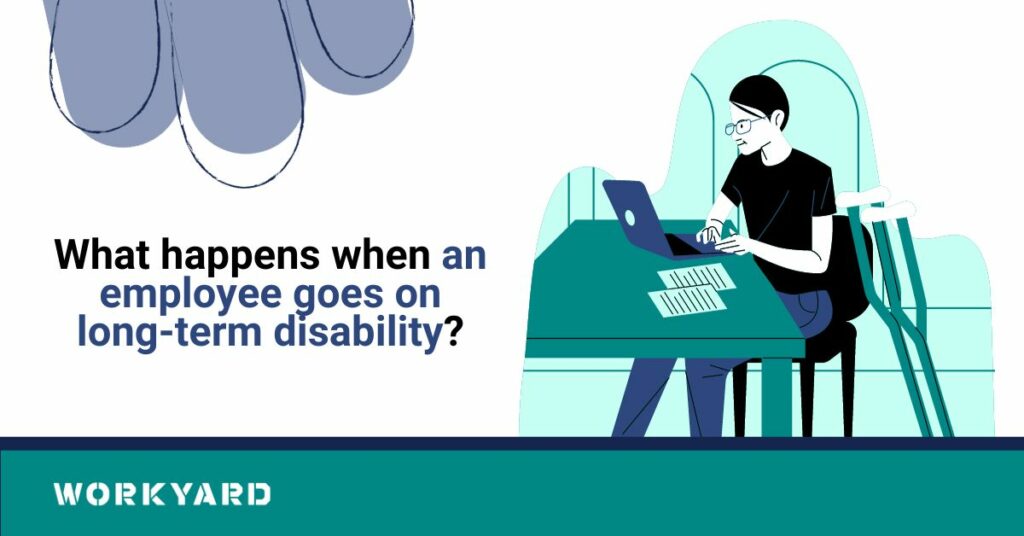When an employee goes on long-term disability, they typically stop working due to an injury, illness, or medical condition that prevents them from performing their job duties. Employers may have policies dictating the length of time a job is held for an employee on long-term disability, and the employee may receive a percentage of their pre-injury earnings as benefits until they are medically cleared to return to work, reach retirement age, or recover from the disability.
This transition can have significant implications for both the individual and the employer, affecting work productivity, financial stability, and overall well-being. Understanding the process and implications of long-term disability is crucial for both employees and employers to navigate this challenging situation effectively.

Credit: linerlegal.com
Initial Steps After Long-term Disability Onset
When an employee experiences long-term disability, taking immediate action is crucial. Here are the initial steps to consider:
Recognizing The Signs
- Observe changes in employee behavior and performance.
- Document any health-related issues affecting work.
- Communicate openly with the employee about concerns.
Filing For Disability Benefits
- Assist the employee in understanding the disability process.
- Gather necessary medical and employment documentation.
- Submit the disability claim promptly to the appropriate insurer.
Impact On Employment Status
When an employee goes on long-term disability, their employment status may be impacted. Depending on the employer’s policies, the length of time the job is held for the employee may be limited. However, long-term disability benefits can provide a percentage of the employee’s pre-injury earnings.
Job Protection Laws
When an employee goes on long-term disability, their employment status is affected by various job protection laws. These laws are designed to safeguard the employee’s position and provide certain rights and protections during their absence due to disability.
Employer’s Policies On Disability Leave
Employers may have specific policies in place regarding disability leave. These policies outline the procedures and guidelines for employees who need to take long-term disability leave. It’s important for employees to understand these policies to ensure a smooth transition and to protect their employment status.
Financial Implications For The Employee
When an employee goes on long-term disability, it can have significant financial implications. Not only does it impact their income, but it also requires adjustments to their lifestyle and expenses.
Income Replacement Percentage
Long-term disability insurance typically pays a percentage of the employee’s pre-disability income, commonly ranging from 50% to 70%. This means that employees may experience a substantial reduction in their earnings, affecting their ability to meet financial obligations and maintain their standard of living.
Adjusting To Reduced Earnings
Adjusting to a reduced income can be challenging for employees on long-term disability. They may need to prioritize their expenses, reevaluate their budget, and potentially seek additional sources of financial support. This adjustment can be emotionally and financially taxing, requiring careful planning and lifestyle modifications.

Credit: www.workyard.com
Understanding Disability Insurance Coverage
Understanding Disability Insurance Coverage is crucial for both employees and employers. When an employee goes on long-term disability, the impact can be significant for all parties involved. By understanding the details of disability insurance coverage, both employees and employers can navigate this challenging situation more effectively.
Policy Inclusions And Exclusions
Disability insurance policies have specific inclusions and exclusions that determine the scope of coverage. It’s important for employees to carefully review their policy to understand what conditions and situations are covered. Common inclusions may encompass disabilities resulting from accidents, illnesses, or medical conditions, while exclusions often relate to pre-existing conditions or specific high-risk activities.
Costs And Premiums
The costs and premiums associated with disability insurance can vary based on multiple factors. Age and occupation risk are significant determinants of the premium amount. As individuals age or engage in higher-risk occupations, the premiums are likely to increase. Additionally, the duration of the waiting period before benefits commence can impact the overall cost of coverage.
Medical Assessment And Claims Process
When an employee goes on long-term disability, they cease working due to an injury or medical condition. The process involves a medical assessment and claims procedure to determine eligibility for benefits, which provide financial support during the period of inability to work.
Medical Assessment and Claims Process When an employee goes on long-term disability, the medical assessment and claims process plays a crucial role in determining their eligibility for benefits. The Role of Medical Evidence is essential in establishing the employee’s medical condition and the extent of their disability. This evidence typically includes medical records, diagnostic tests, and healthcare provider assessments. Navigating the Approval Process involves following specific steps to submit the necessary documentation and information to the insurance provider. The Role of Medical Evidence Medical evidence serves as the foundation for the long-term disability claim. It includes comprehensive medical records, diagnostic test results, and healthcare provider assessments. The severity and impact of the employee’s medical condition are thoroughly evaluated through this evidence, forming the basis for the disability claim. Navigating the Approval Process Navigating the approval process involves understanding and fulfilling the requirements set forth by the insurance provider. This includes submitting the necessary medical evidence, completing claim forms accurately, and adhering to specific timelines. Additionally, the employee may need to undergo medical examinations as part of the approval process. By understanding The Role of Medical Evidence and Navigating the Approval Process, employees and employers can work together effectively to ensure a smooth and successful long-term disability claim.
Credit: aaronenglelaw.com
Returning To Work: The Transition
Transitioning back to work after a long-term disability involves adjusting to the workplace post-injury or illness. Employers may have policies on job retention during this period, emphasizing support and gradual return to duties for affected employees.
Reintegration Challenges
Returning to work after a long-term disability can present various challenges for employees. One of the primary hurdles is the reintegration process, as individuals may need to readjust to the workplace environment, navigate changes in their roles and responsibilities, and rebuild professional relationships.
Workplace Accommodations And Adjustments
Upon returning to work, employees may require specific accommodations and adjustments to support their transition. This can include modifications to their workstations, flexible scheduling, access to medical support services, and tailored training to enhance their productivity and confidence in their roles.
Legal Rights And Protections
When an employee goes on long-term disability, it’s important to understand the legal rights and protections that exist to support them during this challenging time.
Understanding The Americans With Disabilities Act (ada)
The Americans with Disabilities Act (ADA) is a federal law that prohibits discrimination against individuals with disabilities in all areas of public life, including jobs, schools, transportation, and public and private places that are open to the general public. Under the ADA, employers are required to provide reasonable accommodations to qualified employees with disabilities, unless doing so would cause significant difficulty or expense for the employer.
State-specific Disability Laws
In addition to the ADA, each state may have its own specific disability laws that provide additional protections and rights for employees on long-term disability. These laws may offer further guidance on accommodations, benefits, and the legal obligations of employers to disabled employees.
Long-term Planning And Support
When an employee goes on long-term disability, they may cease working due to a disabling injury or illness. Employers often have policies regarding the duration they hold a position for such employees. Long-term disability benefits typically provide a monthly percentage of pre-injury earnings.
Financial Planning For The Future
When an employee goes on long-term disability, it is crucial to consider financial planning for the future. This involves assessing current finances and creating a sustainable plan for the long term.
Seeking Vocational Rehabilitation Services
Another important aspect is seeking vocational rehabilitation services. These services help employees develop new skills or explore alternative career paths to support their long-term well-being.
Frequently Asked Questions
What Are The Cons Of Long-term Disability?
Cons of long-term disability include expensive insurance, coverage exclusions, waiting periods, and no benefits if never disabled.
How Long Is Most Long-term Disability?
Most long-term disability policies provide benefits until the age of 65 or until the person is able to return to work. The exact length of the policy can vary depending on the specific plan and the individual’s needs. It’s important to review the details of the policy to understand the length of coverage and any limitations or exclusions.
What Are Typically Long-term Disability Benefits?
Long-term disability benefits typically provide income replacement until retirement, a set age, or recovery from disability.
Which Situation Would Most Likely Be Covered By Long-term Disability Insurance?
Long-term disability insurance would most likely cover situations like severe illness, injury, or medical conditions preventing work.
Conclusion
Understanding the implications of long-term disability is crucial for both employees and employers. It is essential to navigate the complexities of insurance coverage and job security to ensure a smooth transition during challenging times. Proactive planning and open communication are key for a successful outcome.

